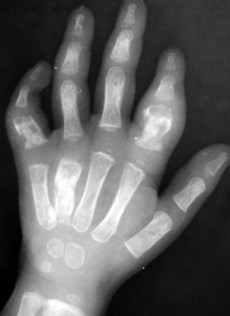249 Sickle cell disease
Salient features
Questions
How would you investigate these patients?
• FBC: haemoglobin 60–80 g/l, with raised reticulocyte count
• Blood smear shows signs of hyposplenism (Howell–Jolly bodies, target cells)
• Sickling of red cells can be introduced by sodium metabisulfite but does not differentiate HbSS from HbAS
• Haemoglobin electrophoresis: there is no HbA, 80–95% HbSS and 2–20% HbF. High HbF levels are associated with a more benign progress. The parents of the patient will show features of sickle cell trait (remember that sickle cell trait protects against Plasmodium falciparum malaria).
Is there any long-term treatment?
• Hydroxyurea and erythropoietin are given to increase synthesis of HbF.
• Allogenic bone marrow transplantation is being investigated as a possible ‘cure’ in severely affected individuals.
• Experimental therapy: induction of HbF by short-chain fatty acids, membrane-active drugs and other experimental treatments.
What is the role of blood transfusion in these patients?
• Steady-state anaemia requires no treatment and regular blood transfusions are given only when the anaemia is severe or if the patient has frequent episodes of crisis, particularly during pregnancy (to suppress endogenous production of HbS).
• Exchange transfusion is used for intractable pain crises, priapism and stroke.







